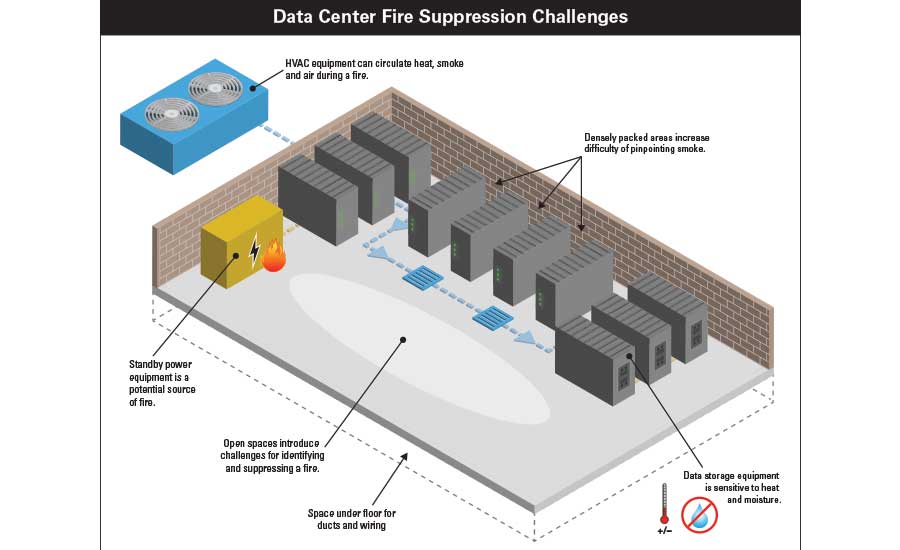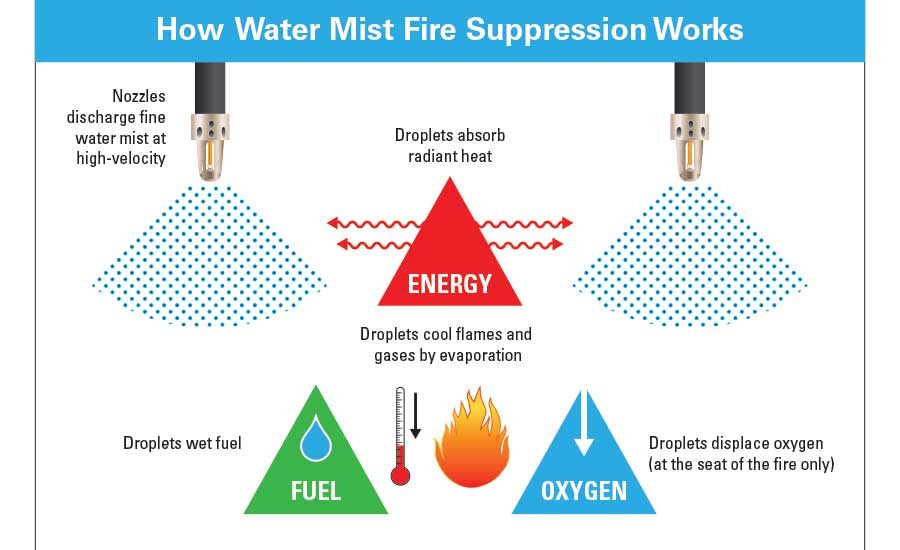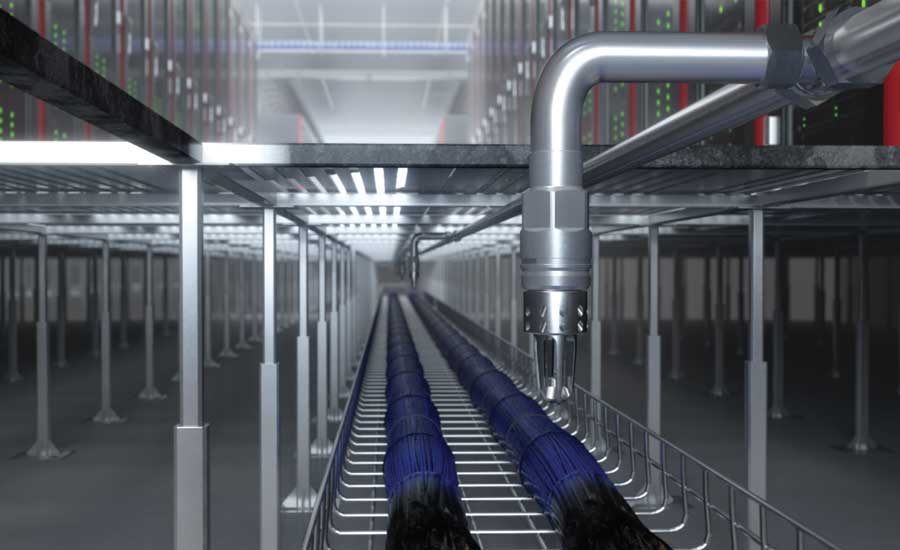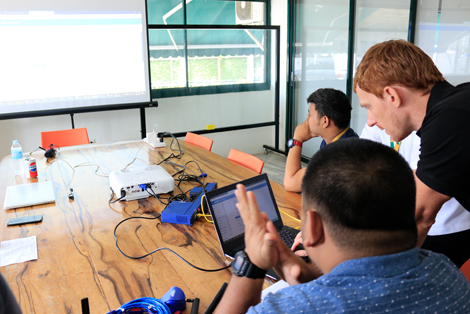The Challenges of Fire Suppression in a Data Centre Environment

Rarely do fires occur inside Data Center facilities. If there is, the fire suppression systems inside should take care of it. The problem here is that the fire solution itself could be as devastating, if not more so, than the fire.
With that in mind, there is a universal requirement for fire suppression equipment in Data Centers all over the world. Keeping the Data Center safe from a devastating fire can be challenging. It’s not like purchasing and installing a few fire extinguishers in locations all over the building. Data Centers have delicate equipment and heat-generating components that could burst into flames spontaneously. Also, Data Centers have people working inside the facility whose lives are in danger. Saving them is the topmost priority, with the second priority being the computer equipment and the building itself.

Data Center Fire Suppression Systems and Priorities
Around the world, different facilities have different guidelines for fire suppression systems. Fire officials and government regulators have rules as to what kind of suppression should be placed in Data Centers. Naturally, it shouldn’t harm the people inside the buildings.
More often than not, these systems can damage the equipment more than saving it. An example of this would be when a downtime incident triggers the accidental discharge of a fire suppression system and damages the servers.
An incident, for example, which took place while testing the fire suppression system on 10 September 2016 at an ING facility in Bucharest has compromised the operations of the data center by destroying dozens of hard drives. This forced the ING to find a nearby backup facility to continue its Romanian operations. The event provided insight to Uptime Institute’s EMEA Network because of the universal requirement for fire protection in Data Centers.
Fires originating from within Data Centers are rare and are mostly caused by electrical failures. Having an effective and functioning fire suppression system, is essential. The system should save lives and protect expensive equipment and critical data. As with any other fire suppression delivery system, it can pose a danger to operations when accidentally activated during testing and maintenance. It can also, when deployed, cause damage to a facility.
To prevent damage to the equipment, inert gas fire suppression systems are preferred among Data Center owners. An inert gas system uses nitrogen and argon to remove the oxygen in a given space. It essentially deprives the fire of oxygen, so the fire will die. A good fire suppression system can extinguish a fire in under a minute. Other automatic fire suppression systems use water or foam to put extinguish fires in Data Centers, but they will inevitably damage sensitive computer equipment.
The Downsides of Inert Gas Systems
An inert gas fire suppression system is the best option for a Data Center to use. The biggest hurdle with inert gas is that it is deployed under pressure.
For an inert gas system to work, it must flood the space with nitrogen and argon immediately. Releasing it at too slow a rate won’t stop the fire before it does extensive damage. Using a pressurized deployment system, the gas is released via an explosive shock wave. The concussive aftermath could damage servers.
Accidental Discharge Issues
According to the Uptime Institute, about one-third of all Data Center operators have at one time or another encountered accidental discharges, occasionally during testing.
The issue here is that an accidental discharge can damage sensitive equipment just as much as an actual fire. Even though it poses no immediate danger to the workers, it could still do some serious damage to the actual Data Center building and easily destroy a lot of computer equipment in mere seconds.
There are solutions. Data Centers in collaboration with their vendors can redesign nozzles to minimize the shock produced by activation and release. Some systems install sensors to alert if a discharge is about to happen. Finally, operators can adjust the equipment they use.
Sound-insulated cabinets, solid-state servers, and racks with barriers can all be used to reduce the damage to the equipment. Operators can move servers away from fire suppressant nozzles to reduce direct impact from the shock wave.
Hazards also include server damage from loud noise during the discharge of inert gas fire suppression systems.
These designs mean that the fire suppression system must meet the standards and potential threats the facility will face in the future.
It’s recommended that facilities have fire and smoke detectors in all areas of the Data Center so, wherever there is a fire, detectors can send out alarms as soon as possible. An adequate supply of fire suppression agent and sufficient dispersion nozzles are ideal to properly protect valuable equipment and data.
Fire Suppression Alternatives
Fire suppression systems should be able to control fire without damaging a Data Center’s contents, and protect its occupants, with minimum residue or pools of water on the floor.
Clean agent fire suppression systems use inert gases that are safe for the environment and displace the oxygen around a fire to suppress it, while others put out the fire through cooling or heat absorption.
A clean agent by The National Fire Protection Association (NFPA) is “an electrically nonconducting, volatile, or gaseous fire extinguisher that does not leave a residue upon evaporation.” Clean agent systems discharge the extinguisher agent from storage cylinders to quickly suppress a fire before it activates the flame/heat nozzles inside the building’s code-required sprinkler system. Once a fire is out, the suppressing agent gases are removed by ventilation. They leave no residue and no equipment damage, and while clean-up is not needed.
The suppressing agents usually include halocarbons, fluorinated ketones, or inert gases (such as nitrogen, argon, or blends thereof). Halocarbons and fluorinated ketones suppress fires by a combination of physical (80%), and chemical (20%) mechanisms without removing the room oxygen. Inert gases suppress fires by means of taking away the oxygen content within a room to the point at which fire is starved.
Water Mist Fire Suppression
Water is the most used suppression agent in all buildings since water sprinklers are usually part of local city fire codes. Sprinkler systems are designed to save structures and save lives. That kind of fire suppression system, however, can be where the cure is worse than the disease. There is an alternative water-based fire suppression system which can minimize the amount of water needed to suppress the fire, and that has been specifically designed for Data Center fire suppression.

Water mist consists of finely atomized water droplets. A high-pressure water mist system produces water droplets, 99% of which measure less than 100 microns in size. These tiny droplets provide a larger surface area for heat transfer. This causes more of the water mist to be vaporized into steam, giving off radiant heat, increasing the cooling effect, to extinguish the fire.
Since water is vaporized during the suppression process, the water mist does not reach the systems’ critical assets, thus minimizing the damage. These systems do not require large amounts of water, as opposed to conventional sprinklers. This is practical especially in locations with limited water supplies, or where municipal water pressure is low. Since the old sprinkler systems rely on using the same water supply as fire hydrant lines (water that can contain sediment and other impurities), water mist systems use potable water which is free of contaminants.
Suppression System Design Approaches
Data Centers are not all the same sizes and configurations, which is important in determining the proper design of a fire suppression system. Areas requiring a fire suppression system can range from specific equipment or assets, a single floor, a room, or an entire building.
Total Flooding Suppression
Data Centers with special computer rooms are protected by a “total-flooding” clean agent systems. When a fire occurs, the entire room is spontaneously flooded with the fire suppression agent. The quantity of fire suppression agent required is based on the overall volume of the protected room. The inert gas must be blended homogeneously throughout that space to achieve an effective concentration.
To completely contain the fire, the room or enclosure must be airtight. All the walls, floors, return air ducts, and ceiling slabs, including doorways and other possible openings, must be completely sealed off. If the room has air ducts, it will make the suppression system ineffective. There must be a means to close them.
Facility Wide Suppression
Clean agent and water mist systems can be used together in facility-wide fire suppression. Choosing between the two is based on potential hazards, economics, and overall fire protection goals. Usually, adding gaseous clean agent systems to supplement standard building fire sprinkler systems is an effective first line of defense for expensive electronics. Gaseous systems are most economical in spaces of under 8,500 square feet and with 15-foot ceilings.
Water mist can be used in the same spaces as clean agents and will cover spaces within the facility not protected by clean agents, such as offices or storage. The water mist system is the facility’s primary fire suppression system, eliminating the need for sprinklers.

Local Applications
Instead of protecting an entire data facility, fire suppression systems can be built to protect a smaller, localized part, or specific equipment inside the area. This saves money over building an entire total-flood suppression system.
Local targets within a Data Center can include areas with potential fire sources, such as HVAC, power and communication cables (often located in subfloors or above floor cable trays) and power rooms (including backup generators, UPS, and battery rooms).
During the design and installation of a localized water mist system, closed, fusible-link, discharge heads must be carefully chosen and positioned to provide maximum coverage. Calculations should include consideration for activation temperature, flow, and distribution patterns for the concerned area. In the event of a fire, the system should only deploy water mist in the spaces where a heat signature is detected.
Many Data Centers prefer to deploy inert gas fire suppression systems. Generally, these systems protect extremely expensive gear. High-end computers, for example, are far more costly to replace than standard X86 servers. In practice, inert gas fire suppression systems replace the water via sprinkler nozzles. The discharge from an inert gas system, however, has also been shown to damage Data Center servers. Inert gas systems are far superior for protecting IT equipment because they do not compromise electronic circuits, even under full operation. In addition, inert gas systems can extinguish deep-seated fires, including those inside the racks.
Sellers of the system have worked to improve the delivery system for the release of the inert gasses by redesigning nozzles and improving sensors to reduce false signals. The Uptime Institute agrees that improvements have been made.
Recommendations From Vendors Regarding the Use of Inert Gas Systems:
- Installing racks that have doors to muffle the noise
- Installing sound-insulating cabinets
- Using high-quality servers, or solid-state servers and memory
- Slowing the rate of inert gas discharge
- Installing walls and ceilings that incorporate sound-muffling materials
- Aiming gas discharge nozzles away from servers
- Removing power from IT gear before testing inert gas fire suppression systems
- Muffling alarms during testing
- Replicating data to off-site disk storage
Despite improvements of inert gas fire suppression systems, pre-action fire suppression (which are water-based or carbon dioxide) systems have become more common. The use of water means that facility owners are insured against the total loss of a data center, and the dry-pipe feature—protects facilities from an accidental discharge in white spaces. It is because they are more economical choices, especially as local codes and ordinances require the use of a water suppression system, whereas the inert gas system is a fairly expensive back-up option.
Still, inert gas fire suppression systems have some followers, and they may make business sense for some companies. Data Center operators can use inert gas applications where water is scarce, or when a Data Center has very expensive and unique IT gear, such as supercomputers in HPC facilities, or old school tape-drive storage. In these instances, it is prudent that organizations would be better off developing improved backup and business continuity plans.
Those Centers considering inert gas suppressions are happy to learn that vendors have made considerable revisions to minimize damage from discharges of inert gas, and improved sensors that register fewer false positives. In addition, they have developed stricter procedures to minimize inadvertent discharge due to human error, which is the most common cause of accidental discharges.
It is recommended that IT management teams work with risk managers to make sure that all stakeholders have an understanding of a facility’s fire suppression requirements and alternatives before choosing a fire suppression system. Operational considerations should also be included so that the system is fitted to an organization’s risk exposure and the business requirements.
Conclusions
Most Data Centers should take advantage of a combination of pre-action (dry pipe) sprinkler system and high-sensitivity smoke detection. Most authorities having jurisdiction (AHJs), risk managers, and insurance companies will agree with this choice as long as other operating requirements are met, such as having a highly-trained staff providing building safety protocols. Local and government safety agencies are quite familiar with water-based fire suppression systems, as they are used by a vast majority of installations in the U.S. They may not, however, always be well-versed with pre-action systems.
Finally, Data Center operators should regularly examine their fire suppression systems and remove inert gas systems from spaces where sensitive equipment is no longer located. Deploying the system where it is no longer needed is no longer practical.
Reference links:
https://journal.uptimeinstitute.com/fire-suppression-systems-bring-risk/
https://www.missioncriticalmagazine.com/articles/93098-data-center-fire-suppression




